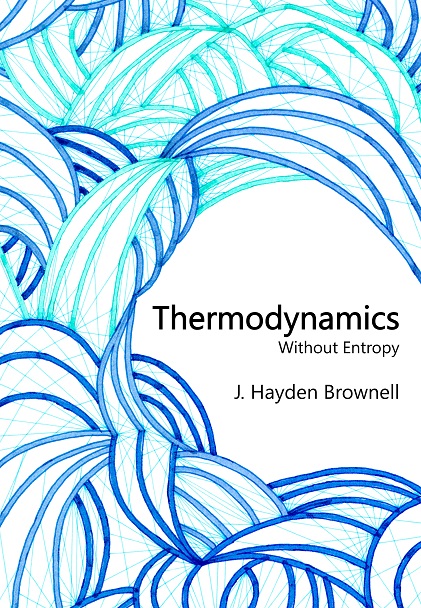
By J. Hayden Brownell, PhD
582 pages
ISBN 978-1-300-79549-0 (hardcover)
ISBN 978-1-300-79556-8 (paperback)
Library of Congress Control Number: 2024926515
Description:
Thermodynamics is the study of very complex systems and so is the foundation for all applied physical sciences. The standard theory is predicated on two assumptions: that entropy is maximum in equilibrium (the Second Law of Thermodynamics) and that fluctuations mimic average flow behavior (Onsager reciprocal relations). Both of these assumptions are shown to be invalid, which is why standard theory remains semi-empirical after 170 years.
Why rely on static 19th century arguments when we now know far more about microscopic dynamics? In this treatise, the author extends quantum mechanics to macroscopic scale, building a concrete bridge from fundamental physics to the phenomena we observe. Transport equations are derived without empirical factors, implying flow is always toward a stable equilibrium steady state. This new theory is comprehensive and achieves unambiguous conclusions directly, without introducing entropy or additional postulates.
This approach also reveals that entropy is not maximum in equilibrium except in ideal systems, contradicting the Second Law. Real systems evolve to a balanced state, not disorder. Standard theory is incompatible with quantum mechanics. This conclusion alters the rationale for all observations, from simple processes to evolution of the cosmos and intelligent life.
Thermodynamics Without Entropy presents a complete theory including all logical steps from fundamental physics to demonstration of a variety of applications. It grounds applied science for physicists, chemists, biologists and engineers of all fields. This book is intended for use as an undergraduate and graduate textbook as well as a research reference.
This treatise is self-published because academic publishers do not produce books of new work, and yet, as Charles Darwin wrote of his experience, “how necessary it is that any new view should be explained at considerable length in order to arouse public attention.” Journal article preprints describing key conclusions are available here.
Table of Contents:
1 Introduction
Part I Qualitative considerations
2 Rationale
3 Defining systems and particles
4 Diffusion and equilibrium
5 Macroscopic energy, heat and friction
6 Particle energy
7 Temperature versus energy
8 Common controlled processes
Part II New Theory of thermodynamics
9 Energy conservation
10 Outside work
11 General strategy
12 Evaluation in equilibrium
13 Equilibrium energy per mode
14 Incremental processes
15 Independent pressure processes
16 Equations of State (EOS) and property relations
16.1 Adiabatic compressibility
16.2 Property fluctuation and correlation
17 Processes involving large changes
18 Transformation kinetics in equilibrium
19 Non-equilibrium dynamics
19.1 Transformation rate
19.2 Particle flow
19.2.1 Classical regime
19.2.2 Quantum regime
19.3 Momentum flow and the stress tensor
19.3.1 Fluid stress
19.3.2 Solid stress
19.3.3 Incremental change in stress
19.3.4 Strain EOS
19.4 Heat flow
19.4.1 Convective energy flow
19.4.2 Conductive heat flow
19.5 Steady flow reciprocal relations
20 Phase stability
21 Quasi-equilibrium process analysis
22 Surface tension
23 Constructing the partition function
Part III Particle interaction models
24 Introduction to particle models
25 Classical ideal gas model
26 Van der Waals fluid model
27 Class I isotropic models
28 Other classical isotropic models
29 Ideal boson gas model
30 Photon "gas" model
31 Ideal fermion gas model
32 Phonon solid state model
33 Bloch solid state model
Part IV Application
34 Homogeneous mixtures
34.1 Multiple species, isotropic, cubic models
34.2 Ideal mixtures
34.3 Mixtures in isotropic virial models
34.4 Mixing fluids in defined volumes
34.5 Fluid mixtures separated by a membrane
34.6 Electrically active mixtures
34.7 Other mixture properties
35 Multiple phase systems
35.1 Ehrenfest equations
35.2 Pure first order phase transitions
35.3 Two component, bi-phase mixtures
35.4 Phase separation
35.4.1 Two component liquid solutions
35.4.2 Solid phase transitions
35.5 Ferromagnetic phase transition
35.6 Superfluidity and superconductivity
36 Cyclical processes: Engines
36.1 Carnot cycle
36.2 Rankine cycle
36.3 Otto and Diesel cycles
37 “Zeroth Law” and “Second Law”
38 Anisotropy from uniform applied fields
39 Sound
40 Brownian motion
41 Fluid dynamics
42 Throttling
43 Black holes
44 Life
45 Societies
Appendices
A Thermodynamic definitions
B Mathematical notation
C Work
C.1 Stress
C.2 Gravity
C.3 Electric
C.4 Magnetic
C.5 Pseudo-force
C.6 Typical work rate
D Material transport equation
E Energy balance derivation
F Derivation of the partition function
F.1 Natural conditions
F.2 Particle population distribution
F.3 System statistics
F.3.1 Fermion systems
F.3.2 Boson systems
F.3.3 Summary
F.4 Further comments
G Gas state partition functions
G.1 Classical ideal gas
G.2 Internal particle modes
G.3 Weak interactions
G.4 Ideal fermion gas
G.5 Ideal massive boson gas
G.6 Massless boson gas
H Critique of standard theory
H.1 Synopsis of the standard theory
H.2 Critique
H.2.1 Opening the Black Box
H.2.2 Issues with Statistical Mechanics theory
H.2.3 Issues with non-equilibrium theory
H.2.4 Comparison of standard and new theories
H.3 Translating standard data
H.4 Conclusion
Index

